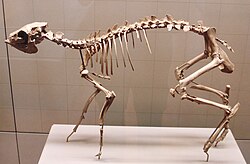Top Qs
Timeline
Chat
Perspective
Sansan paleontological site
Fossil site in France From Wikipedia, the free encyclopedia
Remove ads
The Sansan paleontological site (locally au Campané) is a Miocene fossil deposit in Sansan, in the French department of Gers.
Searched by Edouard Lartet until 1847, it was considered useful for Science and is registered by the Inventaire national du Patrimoine Géologique (InPG) as an international-level site. It constitutes one of the most important Middle Cenozoic deposits and is well known in palaeontological circles.[1] The National Museum of Natural History bought 4 hectares (9.9 acres) of terrain in 1848[2] and oversee any research on the site since then. The research stopped in 1999. The site has been open to the public since 2018.[3]
Remove ads
Location
The paleontological site is located inside the commune of Sansan, on the Campané hill at 238 m (781 ft) above sea level, in the Gers department, 16 km (9.9 mi) south of Auch. The hill and its surroundings were historically called "Camp de las hossos".[4]
Recent history
The deposits were excavated regularly from 1834 to 1999. Francis Duranthon from the Toulouse Museum and Pascal Tassy from the Paris Museum were the last researchers to have worked on Sansan, specifically on the southern flank.
Outcrops were backfilled, vegetation grew back and a paleontological trail[5] was created in 2018 by the Communauté de communes du Val de Gers. Today, research have stopped but the site is open for public access.[6] A 2.5 km (1.6 mi) trail, marked by interpretive panels, helps to teach how Edouard Lartet discovered the site and how his discovery revolutionized the scientific theories of the time and exposed the richness of its Miocene fauna and flora.
- The paleontological trail
- Panel of Édouard Lartet at the beginning of the trail
- The trail
- Interpretive panel on the trail
- Archaeobelodon skeleton near the Ferme du Campané
- Amphycion skeleton
Remove ads
Species list
Summarize
Perspective
The site of Sansan gave 85 mammal species from 9 orders, 30 families and 75 genera, being one of the richest Miocene sites in Europe. One of the most important discoveries on the site was the description by Edouard Lartet in 1837 of Pliopithecus, a catarrhini monkey, which was a keystone in the reject of creationism by scientists and the advance towards the evolution theory.
The first fossil was discovered in 1834 by the shepherd Joseph Débats, who lived on the hilltop. It was a proboscidean molar. He told the Gers lawyer Edouard Lartet, who explored the site. The Sansan mastodont, Archaeobelodon, was entirely reconstructed in 1851 by Laurillard, a first in Europe.
Edouard Lartet describes in 1834 a large carnivore, which he named Amphicyon major.
The first fossils of the chalicothere species Anisodon grande were also recovered in Sansan.
The following table shows all 85 species of mammals found in Sansan.
Chiroptera
Proboscidea
Perissodactyla
Artiodactyla
Rodentia
Lagomorpha
Primates
Insectivora
Carnivora
Remove ads
References
External links
Wikiwand - on
Seamless Wikipedia browsing. On steroids.
Remove ads


































